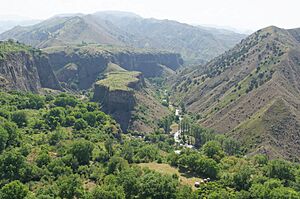Sahakdukht facts for kids
Sahakdukht (pronounced Sah-hak-dookht) was an amazing Armenian woman who lived a long time ago, in the early 700s. Her name means "daughter of Sahak." She was a talented writer of hymns (religious songs), a poet, and a teacher.
Sahakdukht is special because she is the first known woman in Armenian history to create literature and music. She is also one of the earliest women composers ever known, along with another Armenian woman named Khosrovidukht who lived a bit later.
Sahakdukht and her brother, Stepanos Siunetsi, both studied in the ancient city of Dvin. Her brother became a famous composer and music expert. Sahakdukht chose to live a simple life as an ascetic, which means she lived away from others, often in a cave. She lived in a cave in the Garni valley, where she wrote music and taught others.
Even though she wrote many Christian songs, especially for the Virgin Mary, only one of her hymns, called a sharakan, still exists today. This hymn is named "Srbuhi Mariam" ("Saint Mary"). It's a special kind of poem where the first letter of each part spells out her name. Her music helped shape how Armenian hymns developed over many centuries.
Life of Sahakdukht
We don't know much about Sahakdukht's life. Most of what we know comes from a historian named Stepanos Orbelian, who lived in the 1200s. Sahakdukht lived in the early 700s.
Her brother, Stepanos Siunetsi, was also a composer and music expert. Both Sahakdukht and her brother went to a special school at a cathedral in the city of Dvin.
Sahakdukht decided to live a very simple life. She lived as an ascetic in a cave in the Garni valley, which is near where the city of Yerevan is today. There, she wrote religious poems and songs for church services.
Sahakdukht also taught music to children and adults from Garni. Because of the customs of her time, she taught while sitting behind a curtain. This was a way to show respect and privacy.
In 1909, a famous Armenian writer named Sibil talked about Sahakdukht. Sibil used Sahakdukht's story as a teacher to encourage more education for women. She said that even 1200 years ago, Armenians cared about women learning.
Sahakdukht's Works
Sahakdukht is known as the first woman composer and poet from Armenia. She wrote many Christian religious songs, but most of them are now lost. These included ktsurds (which are like short songs or anthems) and sharakans. Her poems often used rhymes and had a set structure. Many of her works were written to honor the Virgin Mary.
The only song by Sahakdukht that we still have today is the sharakan called "Srbuhi Mariam" ("Saint Mary"). This song is a tribute to Mary. It has nine stanzas (sections), and if you take the first letter of each group of four lines, they spell out 'Sahakdukht'.
"Srbuhi Mariam" is similar in style to other hymns of her time, especially those from the Byzantine tradition. This might be because her brother, Stepanos, lived in Constantinople for many years, where important hymn writers were active.
Even though Sahakdukht's "Srbuhi Mariam" is not part of the main collection of Armenian hymns used in church services, her songs had a big impact. A music expert named Şahan Arzruni said that her works "helped to shape the development of the genre during subsequent centuries." Also, some phrases she used in "Srbuhi Mariam", like "incorruptible temple" and "ray of divine light," became very popular in Armenian religious poetry and music.
| "Srbuhi Mariam" ("Սրբուհի՜ Մարիամ")
Սըրբուհի՛ Մարիամ, |
See also
 In Spanish: Sahakduxt para niños
In Spanish: Sahakduxt para niños


